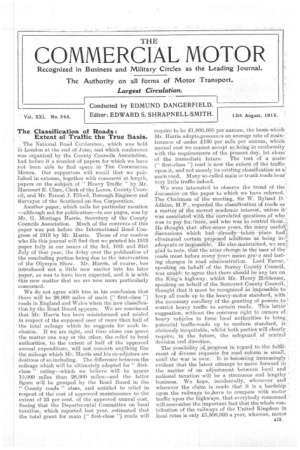COMMERCIAL MOTOR
Page 1

If you've noticed an error in this article please click here to report it so we can fix it.
Recognized in Business and Military Circles as the Leading Journal.
The Authority on all forms of Motor Transport. Largest Circulation.
Conducted by EDMUND DANGERFIELD. Editor: EDWARD S. SHRAPNELL-SMITH.
The Classification of Roads: . Extent of Traffic the True Basis.
. The National Road Conference, which was held iii London at the end of 'June, and which conference was organized by the County Councils Association, had before it a number of papers for which we have not been ableto find space in THE COMMERCIAL MOTOR. Our supporters will recall that we published in extenso, together with Comment at length, papers on the subjeot;of " Heavy Traffic " by Mr. Harcourt E. Clare, Clerk of the Lanes. County Council, and Mr. Ernest J. Elford, Borough Engineer and Surveyor of the Southend-on-Sea Corporation.
Another paper, whiCh calls for particular mention —although not for publication—in our pages, was by Mr. G. Montagu Harris, Secretary of the County Councils Association. Much of the contents of this paper was put before the International Road Congress of 1913 by Mr. Harris. Those of our readers who file this journal will find that we printed his 1913 paper fully in. our issues of the 3rd, 10th and 31st July of that year, the delay over the publication of the concluding portion being due to the intervention of the Olympia Show. Mr. Harris, of course, has introduced not a little new matter into his later paper, as was to have been expected, and it is with this new matter that we are now more particularly concerned. . .
We do not agree with him in his conclusion that there will be 28,000 miles of main (" first-class ") roads in England and Wales Wheri theneW elaSeification by the Road Board appears. We are convinced that Mr. Harts has been misinformed and misled in respect of the supposed user of more than half of the total mileage which he suggests for such inclusion. If we. are right, and time alone can prove the matter one way or the other, the relief to local authorities, to the extent of half of the approved annual expenditure, will not. concern anything like the mileage which Mr. Harris and his co-adjutors are desirous of so including. The difference between the mileage which will be ultimately adopted for" firstclass " rating—which we believe willbe nearer 10,000 miles than. 28,000 miles—and the, latter figure will be grouped by the Road Board in the " County roads " class, and entitled to relief in respect of the: cost of approved maintenance to the extent of 25 per cent. of the approved annual :cost. Seeing that the Departmental Committee on local taxation, which reported last year, estimated that the total grant for main (" first-class ") roads will require to be £1,800,000 per annum, the basis which Mr. Harris ado.ptsepresumes an average rate of main-: tenanoe of under £.130 per mile per annum, which. annual cost we cannot accept as,being in conformity with the requirements of the Present day, let alone: of the immediate future. The test of a maile(' first-class ") road is now the extent of the traffic upon it, and not merely its existing classification as a' main road. Many so-called main or trunk roads bear very little traffic indeed.
We were interested to observe the trend of the: discussion on the paper to which we have referred.' The Chairman.ofthe meeting, Sir W. Ryland D.'
Adkins,..M.P., regarded the classification of roads as . . a matter of the merest academic interest, unless it was associated with the correlated questions of who: was to pay for. them' ,.and who was to control themee He thoughtthataftersonie year, the Many useful: discussion's which bed ' alreadY 'taken --Place had elirninated certain proposed Solutions as being in elirninated certain proposed Solutions as being in .e. adequate or impossiblee Ile also , maintained, we are.fi, glad tcenote, that the..utter change'in thenser of the roads must before Many-years mean grace and lasting changes in road administration. 'Lord Farrar, ' speaking on behalf of the Surrey.County Council, was unable to agree that there should be 'any tax on: the King's highway, whila Mr. HenrY 'Hohhouse, speaking on behalf of the Somerset County Council, ; thought that it must be recognized aS impossible to keep.all roads up to the heavy-motor standard, with the necessary corollaty of the granting of poWers.to-e' restrict heavy traffic, to certain roads. This latter': suggestion, without the converse right to owners of: heavy vehicles to force local authorities to bring:, potential traffic-roads up to modern standard, is.: obViously inequitable, whilst both parties will clearly,' require, . in the . future, the safeguard 'of central decision and .direrAion, The possibility .ot progresS. in regard to the fulfil; rnent diverse requests for road reform is small, until the war is over. It isbecoming increasingly evident that the latest attempt t6 move forward in the matter of an adjustment between local and -national taxation will be a strenuous and lengthy business. We hope, incidentally, whenever and wherever the claim is made that it is a hardship upon the railways toeha.ve to compete with motor traffic upon the highways, that everybody concerned. will remember the important fact that the;whole contribution of the .railways of the -United Kingdom in local rates is only £5,300,000 a. year, whereas, motor






















